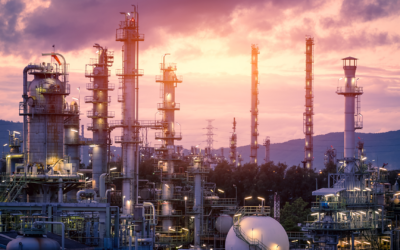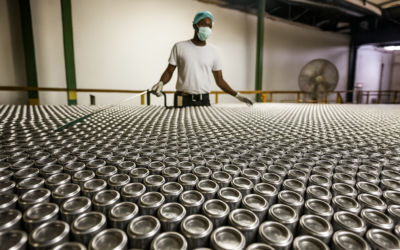This note summarises the results of Sandbag’s modelling of the Carbon Border Adjustment Mechanism (CBAM) applied to imports from the United States into the European Union.
All simulations are based on 2023 trade volumes, assuming these volumes will remain constant over time. However, as the CBAM will ramp up gradually between 2026 and 2034, the effects calculated here assume a full implementation, as planned from 2034 onwards.
Figures are based on Sandbag’s in-house simulations using data from the European Commission, industry associations, academic studies and international databases made with support from the Konrad Adenauer Foundation.

Key findings
- US exporters would face around €351 million in annual CBAM fees, representing just 0.14% of the value of US goods exported to the EU in 2023.
- Accounting for expected price effects that benefit exporters, net costs fall to €160 million, or 0.07% of total exports.
- Even under an expanded CBAM scope covering upstream, downstream, indirect emissions, and new products, the impact would remain marginal.
- Carbon pricing in the US — if introduced — could reduce CBAM fees by half or more.
One CBAM, many options
The impact of the CBAM will depend on assumptions made over the policy’s coverage (products, emissions) and how the EU’s trade partners react. This section describes the set of assumptions used, regarding scope and strategies adopted in reaction to the CBAM, that led to the results that are presented in the next section.
Scenarios
Predicting the CBAM’s impact requires assumptions about the way trade partners will adapt or respond to it. We have considered three scenarios of such reactions described below: business-as-usual, resource shuffling and introduction of carbon pricing.
- Business-as-usual: The US does not introduce carbon pricing to offset. No strategic adjustment by US hence the emissions intensity of goods sold to Europe remains constant.
- Resource shuffling: US exporters strategically redirect their cleanest production to the EU market, lowering their declared emission intensity. While this reduces their CBAM costs, it does not reduce global emissions and may even undermine the CBAM’s climate benefit.
- Steel goods made using electric arc furnaces (EAF) and higher contents of scrap.
- Aluminium goods made of higher contents of remelted scrap.
- Cement products with lower clinker content, and cement rather than clinker.
- Goods made using higher amounts of green electricity.
- Introduction of Carbon Pricing: US implements domestic carbon pricing at 25%, 50% or 75% of the price of EU emission allowances (EUA).
Scope
Given the many possible evolutions of the CBAM, we created five scopes of emissions, including a status quo with the current scope, plus four possible extensions: to upstream products of the ones covered by the current scope (precursors); to a selection of downstream products; to indirect emissions (from electricity use); and to new products.
Current Scope
The current scope corresponds to the coverage described in the CBAM Regulation. The goods covered by the CBAM are summarised in Table 1. It should be noted that this does not take into account the exemptions applicable to goods intended for military purposes, as well as those decided under the ‘Omnibus’ package voted by Parliament on 10 September. The Omnibus amendment will set a minimum threshold of 50 tonnes of net mass of imported CBAM goods per year and per importer, thereby exempting 80% of businesses from the CBAM, according to the Commission.

“Direct” emissions (in the sense of the CBAM) refer to “scope 1” emissions, i.e. that are released into the atmosphere from on-site activities. Indirect emissions are GHG emissions that occur off-site due to the consumption of electricity, often called “scope 2”. Heating and cooling provided from external sources are considered as direct emissions. Only imports of cement, fertilisers and agglomerated ore must pay for both direct and indirect emissions, whereas for all other CBAM goods, the levy will only apply to direct emissions.
Impact on US imports
Fees, revenues and net costs
For importers, carbon costs are the cost of acquiring CBAM certificates. The price of each CBAM certificate is the ETS allowance price (EUA), assumed to be €80. The number of necessary certificates corresponds to the embedded emissions of the goods as calculated by the CBAM methodology.
As illustrated in Figure 1, CBAM fees to be paid for US imports would amount to €351m annually under the CBAM’s current scope in a ‘business-as-usual’ scenario. This would rise to €1211m if the CBAM is extended to all four types of products and emissions simulated (upstream, downstream, indirect emissions and new sectors, described in the Annex). By comparison, US imports of goods into the EU in 2023 were €242 billion3, meaning that CBAM fees would represent around 0.14% of total trade under the current scope, and 0.19% under the extended scope.
CBAM fees would only be marginally reduced in a “resource shuffling” scenario, due to the already low emission intensity of flat steel products made in the US. As a result, US manufacturers would not reduce CBAM duties much further by shuffling inputs around: €347m in the current scope as opposed to €1195m with full extension.
In a scenario where US manufacturers paid for a €40 carbon price (equal to 50% of the EUA price) in their own country, CBAM fees would be discounted by that same amount, reducing CBAM fees applicable to US imports down to €175m. While the likelihood of introducing domestic carbon pricing in the US before the 2030s is low, this scenario illustrates the potential further reduction in CBAM costs for US exporters.

In the news
- Financial Times Sustainable Views, 24 September 2025: US companies have no reason to complain about CBAM, says report
- Euractiv Pro, 24 September 2025: EU carbon tariff will have minimal impact on US exports, climate think tank says
- BusinessGreen, 24 September 2025: Study: Europe’s carbon border levy expected to ‘barely touch US exporters’
- Carbon Pulse, 24 September 2025: US exporters among least exposed to EU’s carbon border levy – report
- Contexte, 24 September 2025: CBAM ‘will barely touch US exporters’ to EU: think tank study
- edie, 24 September 2025: Trump ‘overstating EU carbon tax threat by more than $4bn’
- Trade Finance Global, 24 September 2025: CBAM impact on US would only be 0.07% of total trade, finds new report
- SteelRadar, 29 September 2025: Sandbag: CBAM will affect US exporters less than expected
Related publications
The CBAM dividend for Namibia and Ghana
This research note shows that Namibia and Ghana are likely to benefit from the CBAM, as EU price increases linked to the EU ETS outweigh CBAM fees under current exports. It also sets out transparent transformation scenarios, based on announced industrial projects, to show how expanded and lower-emissions production could further increase export revenues over time.
Chemicals in the CBAM: Time to step up
Sandbag’s latest brief explains why the EU CBAM must be expanded to cover key chemical value chains. With chemicals and refinery products responsible for 30% of industry emissions, phased inclusion is critical to prevent carbon leakage and phase out free allowances.
The EU CBAM: a two-way street between the EU and Africa
Sandbag’s newly released CBAM Simulator allowed us to explore how the EU’s Carbon Border Adjustment Mechanism (CBAM) could impact African exporters — and how cleaner production and carbon pricing could turn a cost into a competitive edge.



